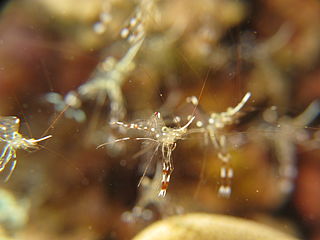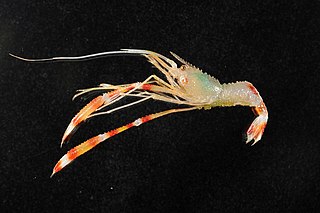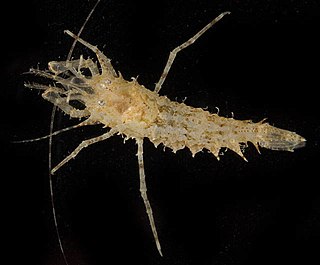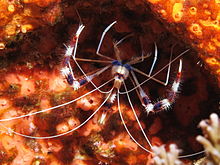
The Caridea, commonly known as caridean shrimp or true shrimp, from the Greek word καρίς, καρίδος, are an infraorder of shrimp within the order Decapoda. This infraorder contains all species of true shrimp. They are found widely around the world in both fresh and salt water. Many other animals with similar names – such as the mud shrimp of Axiidea and the boxer shrimp of Stenopodidea – are not true shrimp, but many have evolved features similar to true shrimp.

Dendrobranchiata is a suborder of decapods, commonly known as prawns. There are 540 extant species in seven families, and a fossil record extending back to the Devonian. They differ from related animals, such as Caridea and Stenopodidea, by the branching form of the gills and by the fact that they do not brood their eggs, but release them directly into the water. They may reach a length of over 330 millimetres (13 in) and a mass of 450 grams (1.0 lb), and are widely fished and farmed for human consumption.

The Decapoda or decapods are an order of crustaceans within the class Malacostraca, and includes crabs, lobsters, crayfish, shrimp, and prawns. Most decapods are scavengers. The order is estimated to contain nearly 15,000 extant species in around 2,700 genera, with around 3,300 fossil species. Nearly half of these species are crabs, with the shrimp and Anomura including hermit crabs, porcelain crabs, squat lobsters making up the bulk of the remainder. The earliest fossils of the group date to the Devonian.

Lysmata amboinensis is an omnivorous shrimp species known by several common names including the Pacific cleaner shrimp. It is considered a cleaner shrimp as eating parasites and dead tissue from fish makes up a large part of its diet. The species is a natural part of the coral reef ecosystem and is widespread across the tropics typically living at depths of 5–40 metres (16–131 ft).

The decapod is made up of 20 body segments grouped into two main body parts: the cephalothorax and the pleon (abdomen). Each segment may possess one pair of appendages, although in various groups these may be reduced or missing. They are, from head to tail:

A cleaning station is a location where aquatic life congregate to be cleaned by smaller beings. Such stations exist in both freshwater and marine environments, and are used by animals including fish, sea turtles and hippos.

Cleaner shrimp is a common name for a number of swimming decapod crustaceans that clean other organisms of parasites. Most are found in the families Hippolytidae and Palaemonidae, though the families Alpheidae, Pandalidae, and Stenopodidae each contain at least one species of cleaner shrimp. The term "cleaner shrimp" is sometimes used more specifically for the family Hippolytidae and the genus Lysmata.

Ancylomenes magnificus, also known as the magnificent anemone shrimp, is a species of cleaner shrimp common to the Western Pacific Ocean at depths of 3–29 metres (10–95 ft). They are commonly found on stony coral, Catalaphyllia and the sea anemone, Dofleinia armata.

Eumunida picta is a species of squat lobster found in the deep sea. The species is strongly associated with reefs of Lophelia pertusa, a deep-water coral, and with methane seeps. It is abundant in the western Atlantic Ocean, where it is found from Massachusetts to Colombia.

Urocaridella antonbruunii, common names clear cleaner shrimp or red-white cleaner shrimp, is a species of shrimp belonging to the family Palaemonidae. It was described by A. J. Bruce in 1967. It is one of the species that are known as cleaner shrimps.

Campylonotoidea is a superfamily of shrimp, containing the two families Campylonotidae and Bathypalaemonellidae. Fenner A. Chace considered it to be the sister group to the much larger superfamily Palaemonoidea, with which it shares the absence of endopods on the pereiopods, and the fact that the first pereiopod is thinner than the second. Using molecular phylogenetics, Bracken et al. proposed that Campylonotoidea may be closer to Atyoidea. There are sixteen described species in 3 genera; no fossils are known.
Juxtastenopus spinulatus is a species of stenopodidean shrimp. It lives in the Red Sea, and across the Indian Ocean as far east as the Philippines. It is red or pink, up to 28 mm (1.1 in) long, with enlarged third pereiopods. Originally described in the genus Engystenopus, it is now placed in the monotypic genus Juxtastenopus, in the family Stenopodidae.

Ancylomenes pedersoni, sometimes known as Pederson's shrimp and Pederson's cleaner shrimp, is a species of cleaner shrimp. It is part of the genus Ancylomenes and was described in 1958 by Fenner A. Chace Jr. as Periclimenes pedersoni. Ancylomenes pedersoni is found in the Caribbean Sea, often associated with a sea anemone, at depths of 1 to 15 metres. They are often found on the reefs off Bermuda.

A shrimp is a crustacean with an elongated body and a primarily swimming mode of locomotion – typically belonging to the Caridea or Dendrobranchiata of the order Decapoda, although some crustaceans outside of this order are also referred to as "shrimp".

Prawn is a common name for small aquatic crustaceans with an exoskeleton and ten legs, some of which are edible.

Stenopus scutellatus, commonly known as the gold coral banded shrimp or golden coral shrimp, is a boxer shrimp, a shrimp-like decapod crustacean belonging to the family Stenopodidae. It is found in suitable habitats in the western Atlantic and the Caribbean Sea.

Crustaceans are a group of arthropods that are a part of the subphylum Crustacea, a large, diverse group of mainly aquatic arthropods including decapods, seed shrimp, branchiopods, fish lice, krill, remipedes, isopods, barnacles, copepods, opossum shrimps, amphipods and mantis shrimp. The crustacean group can be treated as a subphylum under the clade Mandibulata. It is now well accepted that the hexapods emerged deep in the Crustacean group, with the completed group referred to as Pancrustacea. The three classes Cephalocarida, Branchiopoda and Remipedia are more closely related to the hexapods than they are to any of the other crustaceans.

Saron marmoratus, commonly known as the marbled shrimp, is a species of cleaner shrimp in the family Hippolytidae. It is found in the Indo-Pacific region but in 2013 it was also found off the coast of Lebanon, probably having reached the Mediterranean by Lessepsian migration through the Suez Canal from the Red Sea. It is a popular species in aquaria due to its easy care.

Stenopus pyrsonotus is a shrimp-like decapod crustacean belonging to the infraorder Stenopodidea, native to the Indo-West Pacific region. Common names include flameback coral shrimp, ghost boxing shrimp and cave shrimp; the species is sometimes kept in reef aquariums.

Paracrangon is a genus of deep-sea shrimp in the family Crangonidae, found on the Pacific coasts of North America, Asia, and Australia. Morphologically, they are notable for several autapomorphies, most significantly their unique lack of second pereopods, but also for their partially flexible abdomen, which allows them to assume their defensive cataleptic posture. Species also have long spines covering their carapace. They are distinctive among the Crangonid shrimp, and are almost certainly monophyletic. All species except Paracrangon echinata, the type species, are quite rare.























